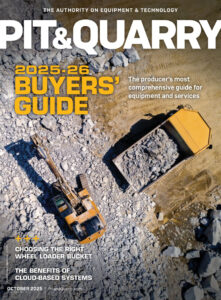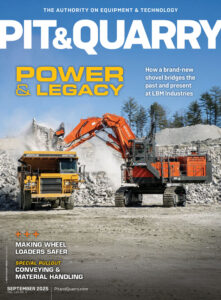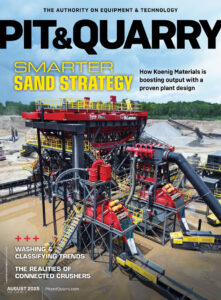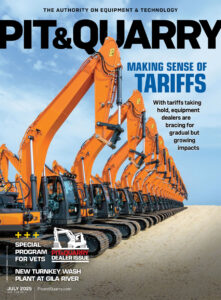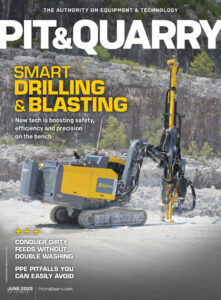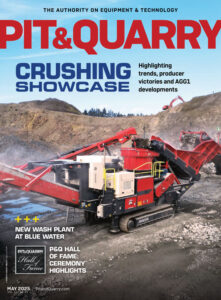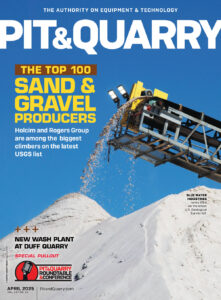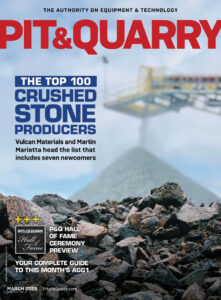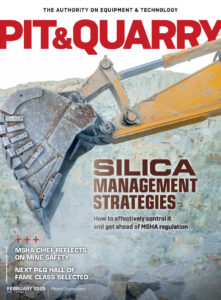Author
Terex Minerals Processing System
The new Terex Cedarapids CRJ3750 portable jaw plant offers high production and numerous options. The rugged CRJ3750 combines a large 37-ft. x 50-ft. JS Series jaw crusher with a high stroke, 52-ft. x 20-in. vibrating grizzly feeder resulting in a high production portable crushing machine. The CRJ3750 is built tough, including a new hopper design, to handle severe primary crushing applications. The highly mobile plant is easy to operate and maintain and offers new levels of reliability and convenience, the company says. Multiple options are available, allowing customers to configure the plant to meet specific needs. Options include a rock breaker, folding hopper wings, hydraulic jacks, hydraulic deployed switchgear and quad or 3+1 axle configurations. Terex MPS offers an extensive range of crushing and screening equipment that gives producers the flexibility to tailor a portable, modular or stationary system to their needs. www.terexmps.com Photo: Terex Keep Reading
Honeywell website creates customized hard hats in 4 steps
Honeywell launched Build Your Own Hat, a Web-based application that lets safety managers customize their company’s hard hats in four steps. Users are asked to select the style of hat, choose a color, specify a suspension and upload a logo or graphic. Build Your Own Hat features a 360-degree, rotating product view as well as side-by-side comparisons of up to three custom caps. All styles of safety caps from Fibre-Metal and North can be customized. They span the full range of ANSI and CSA ratings for impact and electrical protection; a bump cap also is available. In addition, Build Your Own Hat offers a selection of suspension options, with hats that feature four-point, six-point and the industry’s only eight-point suspension, Fibre-Metal SuperEight. Users may also choose from best-in-class headgear options such as SwingStrap, TabLok and Quick Fit for quick and easy adjustability. Also available are 19 shell colors. Users can choose from stock safety slogans and graphics, or upload their own custom graphics and logos. Honeywell says a customer service… Keep Reading
Natural Resource Partners president, COO to retire
Natural Resource Partners LP (NRP), a company in the business of owning and managing mineral reserve properties, says President and Chief Operating Officer Nick Carter will retire Sept. 1. Succeeding him as president will be Executive Vice President Wyatt L. Hogan, who will be responsible for the company’s continued growth and diversification. In addition, he will take Carter’s place on the board of the National Mining Association. Hogan will report to Corbin J. Robertson Jr., NRP's chairman and CEO. Executive Vice President of Operations Kevin F. Wall will succeed Carter as chief operating officer and will report to Hogan. The Vice President of Business Development for the company’s coal business, Kevin J. Craig, will take on additional responsibilities related to coal industry relations. He also will report to Hogan. Carter will work as a consultant to NRP through the end of 2014 to help ensure a seamless transition, according to the company. Robertson thanked Carter for his dedication to the company for the past 24 years. “Under Nick’s leadership, NRP… Keep Reading
NSSGA gives OSHA additional info on proposed silica rule
NSSGA filed additional information and data with OSHA following the agency’s public hearings in March and April on a proposed respirable crystalline silica rule. OSHA’s proposed rule includes a new exposure limit for respirable crystalline silica and details widely used methods for controlling worker exposure, conducting medical surveillance, training workers about silica-related hazards and recordkeeping measures. It includes two standards: one for construction and one for general industry and maritime employment. OSHA says it currently enforces 40-year-old permissible exposure limits for crystalline silica in general industry, construction and shipyards. It believes the limits are outdated, inconsistent between industries and do not adequately protect worker health. NSSGA says OSHA’s proposal is important to its members because a silica standard would directly affect ready-mix and asphalt concrete operations, many aggregate sales yards, and practically all members’ customers. OSHA's regulatory analysis also will have an impact on the silica rule for mining operations that MSHA plans to propose. MSHA intended to publish its proposal this month, however this target date has since changed, according to… Keep Reading
Incorporating a rail line into a quarry and transportation system
Missouri was a hotbed of rock formation several hundred million or a few billion years ago. Magma periodically flowed beneath and above the surface of the earth, cooling and hardening. Today, the southern part of the Show Me State contains vast tonnage of Precambrian granite and trap rock to show for its molten past. Trap Rock and Granite Quarries LLC’s reserves feature Missouri red granite and trap rock deposits. This year, the company will begin to tap the rich groundswell with a state-of-the-art quarry loadout operation. The plan Trap Rock and Granite Quarries owns 3,200 acres in southern Illinois and southeast Missouri, with more than 1,100 of those acres situated 85 miles south of St. Louis near Iron Mountain, Mo. The 1,100-acre parcel was purchased three years ago after geologists concluded it contains an estimated 1 billion tons of granite and trap rock. But just as enticing to the company was what lay adjacent to the property: a main line of the Union Pacific Railroad. Union Pacific has about 1,400… Keep Reading
Why 2014 is the year of the workers’ voice
MSHA has recently expressed concern about fatalities in the aggregates industry and about employees taking risks by not focusing on potential consequences. The agency has emphasized that fundamental procedures, such as locking out and blocking equipment, are indispensable to preventing fatal releases of energy. It has further stressed the importance of operator reinforcement of safe procedures with regular training and monitoring of how miners are doing their work. There also appears to be tacit recognition that sometimes employees are not the best judge of their own competence on new assignments. MSHA is encouraging operators to provide and verify task training anytime there is a question. With that said, MSHA is also urging miners to insist on safe workplaces, and is emphasizing what miners can do to identify, correct and report unsafe conditions or actions. MSHA believes uninhibited communications between employees and companies can promote beneficial safety adjustments. MSHA stresses that miners who exercise safety rights, lodge complaints, talk to inspectors, or refuse work they consider unsafe are legally protected from… Keep Reading
6 steps to streamline mobile processing
Six simple solutions to enhance culture, improve safety and increase profits. Have you ever found yourself waiting impatiently at a traffic light when there were clearly no cars coming in the other direction? Do you ever find yourself looking for something that you use almost every day, such as your car keys or your cell phone? Have you ever spent a few minutes going through your closet looking for a favorite shirt, only to find yourself filling up a large bag full of clothes destined for Goodwill? We deal with wasteful activities like these on a daily basis. And if you are engaged in mobile processing, you are acutely aware of the many challenges with which you’re faced. Below are common challenges portable producers face: Equipment that must be highly efficient and reliable while producing maximum volumes and having the flexibility to produce an array of product specifications or adapt to any material condition. The loss of revenue associated with downtime between moves to prep, clean, tear down, load, set… Keep Reading
Rebuild: Eriez
The Eriez 5-Star Service Center in Erie, Pa., is fully staffed and equipped to rebuild all Eriez equipment, as well as competitor models. Once remanufactured, all Eriez equipment leaves the facility with an “as new” warranty. Manager of Service and Repairs Dave Hansen says, “Our comprehensive rebuild program includes complete diagnostics, teardown, inspection, updated electronics and assemblies, and testing.” The service team utilizes original OEM parts, components and assemblies for all jobs. A variety of equipment can be rebuilt through Eriez 5-Star Service, including vibratory feeders, drum magnet separators, wet drum separators, suspended electromagnets (shown here) and more. When it’s not practical to send equipment to the service center, the team is available for onsite equipment testing and repair. Keep Reading
Tips and technologies for hydraulic breaking
Following these tips and technologies for hydraulic breaking can save producers money and downtime. About as long as man has known rock, people have been designing and perfecting tools to demolish it. In recent years, hydraulic breaker technologies have evolved rapidly to include advancements that not only optimize breaking efficiency and reduce operating costs in mining and aggregate applications, but they help minimize downtime on the job. While performance of a breaker has traditionally been measured by the tons of rock per hour, says Stephane Giroudon, strategic account sales manager for Doosan, a breaker’s cost per ton is quickly becoming the industry standard. One of the easiest ways to keep your tool’s cost-per-ton ratio low is to identify technologies that help reduce the effects of the constant beating breakers take in the high-psi conditions associated with mines and quarries. Additionally, there are best practices that can contribute to the extended life of your attachment and your excavator. High-impact technologies The power and versatility of high-impact breakers allow operators to perform… Keep Reading


